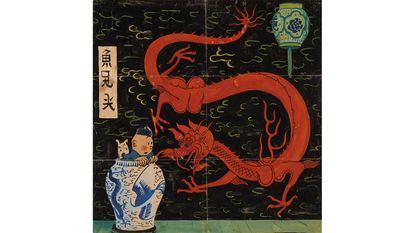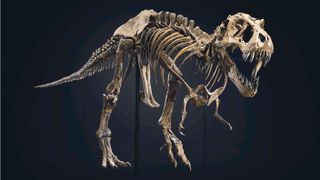Collectables: market in Tintin artwork takes off
Tintin, the Belgian boy-reporter cum adventurer, is in demand once again. Chris Carter reports.


Last year, a drawing of young cartoon reporter Tintin carving a propeller from a tree trunk sold for $1.1m with Dallas-based Heritage Auctions. It was special because it was the original artwork used for the first published magazine cover to feature Tintin in February 1930. It was a fitting illustration because the market in artwork by Tintin’s Belgian creator, Georges Rémi, known as Hergé, has truly taken off in recent years. The current price record was set in 2014, when a signed page of drawings from 1937 fetched €2.6m with Artcurial. The Parisian auction house boasts that eight out of the ten most expensive works by Hergé at auction have gone under its hammer.
Tintin’s faux pas
On 21 November, that number looks set to become nine when the initial artwork for Le Lotus Bleu goes up for sale. The Blue Lotus, as it’s called in English, was published in 1936. It is the fifth album in the series, and sees Tintin travel to China to disrupt the opium trade. He is assisted in his mission by the trusty Chang, and there is a good reason for his appearance. The previous four albums had tended to draw on “clichés and crude stereotypes”, as the official Tintin website puts it. Indeed, the notorious second album, Tintin in the Congo (1931), came under renewed scrutiny during the 60th anniversary of Congolese independence from Belgium this summer. The Blue Lotus marked a turning point (although, as Sam Leith notes in The Daily Telegraph, some might still take issue with the depiction of the “toothy, sadistic, harakiri-prone Japanese”). Hergé did his research on Chinese culture and the work expresses the evolution of Hergé’s thinking. The Blue Lotus is indeed considered to be one of the better Tintin adventures.
The initial artwork Hergé produced for it was, however, never used. The Indian ink, gouache and watercolour on paper image of Tintin and Milou (Snowy) peeking out from a Ming vase, while seemingly being menaced by a Chinese dragon (look closer and you will see it’s actually the wallpaper), was deemed too costly to reproduce with the four-colour technique used in 1936. The publisher, Louis Casterman, turned it down. According to the auction house, Hergé gave it to the publisher’s young son, who kept it in a drawer (see right).
Subscribe to MoneyWeek
Subscribe to MoneyWeek today and get your first six magazine issues absolutely FREE

Sign up to Money Morning
Don't miss the latest investment and personal finances news, market analysis, plus money-saving tips with our free twice-daily newsletter
Don't miss the latest investment and personal finances news, market analysis, plus money-saving tips with our free twice-daily newsletter
“This artwork is a genuine masterpiece encapsulating Hergé’s genius and is probably the most beautiful Tintin album cover ever!” says Eric Leroy, comic-strip expert at Artcurial. Artcurial has valued the artwork at up to €3m for the sale next month.
A disputed history

It will be the first time Hergé’s initial artwork for The Blue Lotus goes up for auction. The piece was inspired by a picture of Anna May Wong, the Chinese-American actress who appeared with Marlene Dietrich in the 1932 film Shanghai Express, says Bruno Waterfield in The Times. After it was rejected for being too expensive to reproduce, Hergé (pictured) gave it to Jean-Paul Casterman, the publisher’s young son. The boy tucked it away for safe-keeping. That’s the official version of events. “Hergé’s old friends say this account is as fanciful as any Tintin tale: they are aghast that the picture is up for auction, and say it was pinched from the author,” says Leo Cendrowicz on i news.
“I met Jean-Paul in 1990 and he told me that it was a present from Hergé, who didn’t think the rejected picture had any value,” Eric Leroy, Artcurial’s comic-book expert, tells Cendrowicz. (Hergé died in 1983, and the younger Casterman in 2009. The present sellers are the latter’s children.) “Tintinologists… say it is inconceivable that Hergé… would have given it to a boy he’d never met,” says Cendrowicz. Hergé always signed his gifts, they point out, and the timing of the sale comes “just months after the deadline lapsed for any legal challenge to the picture’s ownership”. One theory is that Hergé sent the image to the publisher and it was simply never sent back. Either way, the sale is going ahead and it is expected to set a new auction record for a European comic-strip drawing next month.
Auctions
Going…
Around 440 rare cinema posters are heading for auction with the Prop Store in London on 5 November. Together, they are expected to fetch at least £180,000. The top lot is a Dr. No poster from 1962, featuring the famous “007” gun logo for the first time. It is expected to sell for at least £8,000. An Australian Mad Max poster from 1979, considered the “holy grail” of posters for this film, has been valued at between £3,000 and £4,000. And a Star Wars: The Empire Strikes Back (1980) poster is estimated to fetch from £2,500. But “the auction is suitable for fans with a variety of budgets”, says MSN.com. At the lower end of the price spectrum, a poster advertising Jurassic Park, from 1993, has a price tag of £100-£200.
Gone…

“We’re in a brave new world when a 167-million-year-old dinosaur proves the most contested lot in a virtual auction of 20th-century fine art,” says Melanie Gerlis in the Financial Times. But that is what happened at the Christie’s evening sale in New York last week. The male Tyrannosaurus rex from the Late Cretaceous period, nicknamed Stan, “roared ahead” from an initial $3m bid to sell in London for a record $31.8m (with fees). It was in a “remarkable state of preservation” thanks to its final resting place in a small streambed, according to the auction house. “It is one of the largest, finest, and most complete specimens ever found of the undisputed king of the dinosaurs.”
Chris Carter spent three glorious years reading English literature on the beautiful Welsh coast at Aberystwyth University. Graduating in 2005, he left for the University of York to specialise in Renaissance literature for his MA, before returning to his native Twickenham, in southwest London. He joined a Richmond-based recruitment company, where he worked with several clients, including the Queen’s bank, Coutts, as well as the super luxury, Dorchester-owned Coworth Park country house hotel, near Ascot in Berkshire.
Then, in 2011, Chris joined MoneyWeek. Initially working as part of the website production team, Chris soon rose to the lofty heights of wealth editor, overseeing MoneyWeek’s Spending It lifestyle section. Chris travels the globe in pursuit of his work, soaking up the local culture and sampling the very finest in cuisine, hotels and resorts for the magazine’s discerning readership. He also enjoys writing his fortnightly page on collectables, delving into the fascinating world of auctions and art, classic cars, coins, watches, wine and whisky investing.
You can follow Chris on Instagram.
-
 Private school fees soar and VAT threat looms – what does it mean for you?
Private school fees soar and VAT threat looms – what does it mean for you?Rising private school fees could see more than one in five parents pull their children out of their current school. Before you remortgage, move house or look to grandparents for help, here’s what you need to know.
By Katie Williams Published
-
 Best and worst UK banks for online banking revealed
Best and worst UK banks for online banking revealedWhen it comes to keeping your money safe, not all banks are equal. We reveal the best and worst banks for online banking when it comes to protecting your money from scams
By Oojal Dhanjal Published
-
 AstraZeneca CEO’s £1.8mn pay rise approved despite shareholder opposition
AstraZeneca CEO’s £1.8mn pay rise approved despite shareholder oppositionAstraZeneca hiked its dividend to persuade shareholders to accept CEO Pascal Soriot’s pay rise. Is he worth his salary?
By Dr Matthew Partridge Published
-
 Adidas, Nike or Jordans - could collectable trainers make you rich?
Adidas, Nike or Jordans - could collectable trainers make you rich?The right pair of trainers can fetch six figures. Here's how you can start collecting vintage Adidas, Nike or Jordans now
By Chris Carter Published
-
 The industry at the heart of global technology
The industry at the heart of global technologyThe semiconductor industry powers key trends such as artificial intelligence, says Rupert Hargreaves
By Rupert Hargreaves Published
-
 Three emerging Asian markets to invest in
Three emerging Asian markets to invest inProfessional investor Chetan Sehgal of Templeton Emerging Markets Investment Trust tells us where he’d put his money
By Chetan Sehgal Published
-
 What to consider before investing in small-cap indexes
What to consider before investing in small-cap indexesSmall-cap index trackers show why your choice of benchmark can make a large difference to long-term returns
By Cris Sholto Heaton Published
-
 Why space investments are the way to go for investors
Why space investments are the way to go for investorsSpace investments will change our world beyond recognition, UK investors should take note
By Merryn Somerset Webb Published
-
 Time to tap into Africa’s mobile money boom
Time to tap into Africa’s mobile money boomFavourable demographics have put Africa on the path to growth when it comes to mobile money and digital banking
By Rupert Hargreaves Published
-
 M&S is back in fashion: but how long can this success last?
M&S is back in fashion: but how long can this success last?M&S has exceeded expectations in the past few years, but can it keep up the momentum?
By Rupert Hargreaves Published